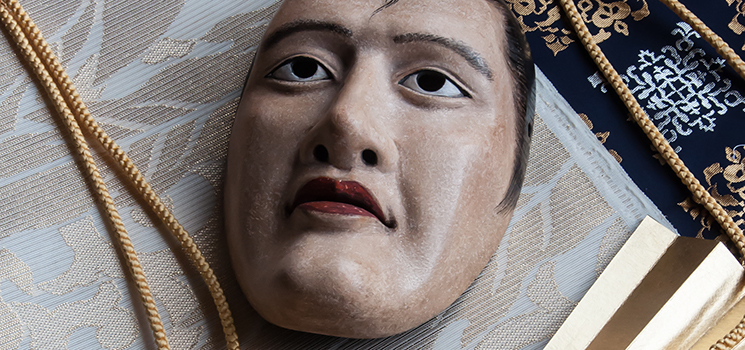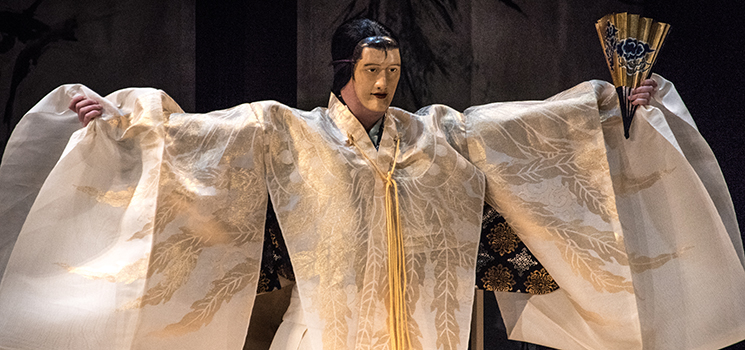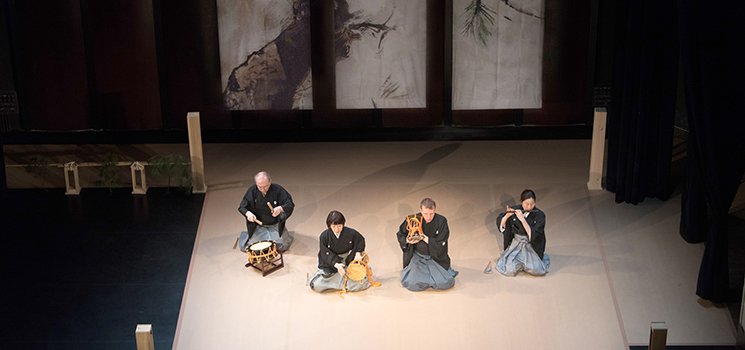News

Elvis as You've Never Seen Him
An ancient Japanese theater form (in English) sheds light on the relationship between celebrity and humanity in Theatre Nohgaku's "Blue Moon Over Memphis"
Since his death in 1977, there have been countless movies, books, articles, tributes and parodies about Elvis Presley. On Monday, Oct. 15, perhaps one of the most unusual portrayals of the rock and roll legend will be on display when Blue Moon Over Memphis, an English-language Noh play written by Deborah Brevoort and scored for the Noh theater by Richard Emmert, will be performed at UCLA as part of “2 Days of Noh,” presented by UCLA, Waseda University and Theatre Nohgaku.
Noh, a traditional style of Japanese theater, is more than 600 years old but continues to be a thriving theater practice in Japan. Theatre Nohgaku specializes in keeping the theater form relevant and relatable to American audiences by presenting Noh plays in English. UCLA TFT’s Noela Hueso recently sat down with company member and UCLA TFT Department of Theater Professor Tom O’Connor, who performs in and was responsible for bringing the production to UCLA.
Why Elvis? How does his story fit in the Noh construct?
Tom O'Connor: Elvis is the American Genji. Heroic, but also flawed. He is instantly recognizable (to anyone over 30, at least). This is important in Noh, because the form relies on the audience’s shared knowledge of the story of the personage being portrayed. Also, Noh relies heavily on poetic allusion, and so some of the songs we associate with Elvis may be conjured by just a word or two. You can’t say that about many musical figures.
How does Noh compare to other forms of theater or drama?
In most [contemporary] theater, there’s an attempt to make something brand new; something that will be visually impressive, that will assault the senses with different types of technical effects and amplified sound. Noh uses none of that. There are no lighting effects. The show that we are going to perform has only one lighting cue, which is lights up. [Noh is usually performed in a lit theater.] The locale, character and action are all conveyed through the actor's body and through the costume and the wooden mask the lead actor wears. It has a fixed expression, of course, but merely through the interplay with available light and by tilting the mask ever so slightly, the performer can help the audience project different types of emotion onto the mask.
Aren’t there two lead actors in Blue Moon Over Memphis?
Blue Moon is what’s called a mugen, or “phantom” Noh and follows this convention: A traveler (in this play, a woman named Judy) goes to a place and encounters an unusual person of that place (the Southern Gentleman); that person mysteriously vanishes only to return in their true guise as a famous person we all know from the past — in this case, Elvis Presley. The Southern Gentleman and Elvis are played by the same actor.
What are some of the other conventions?
A Noh play starts and ends with an empty stage. The story is told through the actors' bodies, mostly. Rather than showing you something that makes you think you're somewhere else, the actors invite you to imagine another place. So, a character can travel miles by simply walking in a circle on the stage. It’s really a theater about engaging and challenging the imagination.
Noh costumes are very elaborate, aren’t they?
Yes. Some of the costumes that are held in a Noh performing family are hundreds of years old. They’re very precious and very expensive and one size fits all. The costume literally has to be sculpted and sewn onto the actor.

So, there are no costume changes.
There are, actually — and they’re difficult. There will usually be a short entr’acte at which time the actor will go offstage to get changed — and it will take three people to help him do it.
How unusual is an English-language Noh?
There is no other company in the world that does this. We are a collection of people who live in the U.S., Japan, Canada, and the U.K., who all are committed to training in Noh and then gathering, like we are next week, and creating a piece of theater.
Who is this play going to appeal to?
We want to make theater that appeals to everyone. People coming to this with no knowledge of Noh are going to be struck by the experience as being different than any other performance that they’ve ever seen. People who have a particular interest in Elvis Presley will deeply appreciate the sympathetic approach that this play takes toward him as a victim of the business, the machine that is the industry. People who are specifically interested in Japanese Studies and forms will be intrigued by how an ancient practice can translate to a new milieu. Anyone engrossed in transnational performance or studies, an idea that crosses over many of the disciplines in our campus, will appreciate seeing a theater company that is founded on a transnational model.
Why should someone who is unfamiliar with Noh come and see this play?
For one, to have a window into the form. If you were to go to Japan and see a Noh play in Japanese, as I did in 1991, you probably would be completely lost, as I was. This is a way to become [acquainted with the form]. You will have a way in both through the English language and through your larger knowledge of stardom and a particular victim of it.
How does this production reflect the TFT vision?
This is a production that exemplifies the possibility of what happens when you engage in another culture: How do you allow yourself to be positively influenced by that without stealing from it, without cultural appropriation? We are submitting ourselves as students to the form and allowing the form to live within us and then using it to tell our own stories or stories of our own culture.
Has anything like this ever been performed at UCLA?
I don’t think English Noh has ever been performed at UCLA. Two of the performers who will be present in our production, however, Richard Emmert and Akira Matsui, were in residence 15 or 16 years ago. Both were brought in to teach a class by [UCLA TFT professor emerita] Carol Fisher Sorgenfrei when she was a professor here.
You were instrumental in bringing Blue Moon to UCLA and you also perform in it. What is your role?
I will be singing in the chorus. I also designed and built the tsukurimono — one small set piece, which is supposed to represent the Graceland gate. A stage attendant carries out this little prop and sets it down and, just like that, we’re in Graceland.
That’s another sign of Noh, right? There's hardly any set.
Hardly. Some have none, many others have a single small item that represents the change in locale.

The use of a fan is also significant. Can you elaborate?
You need two things when performing Noh: The fan and the tabi — bifurcated socks that are worn; feet are very expressive in Noh. The fan becomes an extension of gestures. When the fan is closed, it has the shape of a stick or a rod. When the fan is open, it is flat. From these two very basic shapes, any number of possible objects can be imagined. When it's open, a fan can become a pitcher pouring saki. When it’s closed, it can become a sword. It’s not becoming in any realistic sense but it’s more of an indexical sense — the fan and the gesture imply something that leads you to finish the picture. From that, and from hearing the story, you understand what is happening.
Part of what makes Noh so distinctive is the music and the calls that the musicians make.
There is a floutist and three drummers in the hayashi ensemble: taiko, otsuzumi and kotsuzumi, and each of the drums makes a different sound. The drumming itself is only a very small part of what a drummer does. The calls they make are also very important. They each have a repertory of drum calls, depending on what instrument they’re playing. At first these calls are jarring and strange, but they grow on you. Taken together, the sounds of hayashi instrumentation are incredibly moving, when you give in to them.
How did you become interested in Noh?
I got into it through being exposed to butoh, which is an experimental dance theater form. When I stumbled into a Noh performance at the National Noh Theater, even though I had no idea what was going on, I knew that I was in the presence of something ferocious, something that was really alive.
I am now doing something — a big part of my professional life — that I’d never heard of when I was in college, so that affects the way I think about theater training. I’m interested in training people for the possibilities, training someone to do something that neither of us can even imagine yet, cultivating students’ ability and interest in investigation, getting them to ask not just, ‘How is it usually done?’ but ‘What’s possible?’

Blue Moon Over Memphis is presented by UCLA, Waseda University and Theatre Nohgaku, and made possible by grants from the UCLA Arts Initiative and the Yanai Initiative. Additional support provided by the Terasaki Center for Japanese Studies, the UCLA Department of Theater, and the Japan Foundation Los Angeles.
Blue Moon Over Memphis was developed in part with assistance from the Orchard Project, a program of The Exchange.
October 15, 2018
7:00 p.m.
Glorya Kaufman Dance Theatre
Kaufman Hall, UCLA
$30 VIP tickets with bento dinner
$15 general admission
$10 UCLA faculty and staff
Students free at the door with ID
https://www.yanaiinitiative.org/twodaysofnoh

Posted: October 9, 2018





